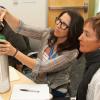
New Educational Project Aims to Improve Interprofessional Team Communication
Thanks to an $18,000 grant from UCSF Library’s Instructional Grants Program, a team of educators from across three UCSF schools is hoping to improve interprofessional team communication through an innovative web-based curriculum that will combine multimedia presentations and interactive learning.
The idea for the curriculum, says principal investigator and pediatric hospitalist Darren Fiore, grew from observations he and others made during pediatric mock code sessions at the Kanbar Center for Simulation, Clinical Skills and Telemedicine Education. “Learners were focused on the clinical details, but we were missing opportunities to foster team communication skills,” Fiore says.
Fiore and an interdisciplinary team that includes investigators and consultants from pediatric medicine, nursing, pharmacy and respiratory therapy have set out to create a succinct, evidence-based curriculum to highlight the principles of interprofessional communication and provide a foundation for advanced team-training exercises that can be used in clinical settings and across all four schools at UCSF.
An Opportunity to Reduce Medical Errors
“Good communication” isn’t just a buzz phrase. There is ample evidence that ineffective communication between health care professionals – or between health care professionals and patients/families – contributes to medical errors. In a 2007 report, The Joint Commission noted that nearly two-thirds of sentinel events between 1995 and 2005 were a result of communication failures. A sentinel event, according to The Joint Commission, is “an unexpected occurrence involving death or serious physical or psychological injury, or the risk thereof.”
Part of the challenges with communication in an interprofessional setting, says Mary Lynch, clinical professor in the UCSF Department of Family Health Care Nursing and a co-investigator on the project, is that although we may use the same language, our interpretation of verbal and nonverbal expressions may lead to a misunderstanding or miscommunication of a clinical assessment.
For example, during an intubation for a sick child, the physician and nurse may be discussing the differences in their interpretation of breath sounds. If they don’t clearly articulate their concerns, the respiratory therapist assisting with the intubation may not realize that the intubation was unsuccessful. Therefore it’s crucial that all interprofessional colleagues in health care environments understand each other clearly – particularly, for example, under the extreme stress of caring for a critically ill child.
A Curriculum with Six Modules
Giving clear messages is among the six potential module topics in the curriculum. The other five are (1) identifying clear roles and responsibilities, (2) engaging in constructive intervention and feedback, (3) cultivating mutual respect and collective trust, (4) sharing knowledge and planning and summarizing information and (5) knowing individual and team limitations. Each module will contain text, short video vignettes, voice-over narration and interactive activities designed to reinforce learning.
The team will first develop the modules, then pilot them with practitioners and trainees in the pediatric mock code program beginning in January 2013. Investigators will evaluate the modules’ efficacy by comparing learners’ pre- and postcurriculum knowledge, skills and attitudes with brief assessment tests. Mock code facilitators will also assess team performance using data from before and after the pilot implementation.
Fiore, Lynch and their co-investigators anticipate making the curriculum available to practitioners and trainees across the medical center and all four schools in July 2013, after making any necessary refinements based on learner evaluation and feedback. Thanks to its web-based structure, if the curriculum proves effective, it can eventually be used by learners in other institutions, along with a planned “teacher’s manual” that will offer guidance on how educators can incorporate the modules into their own curricula.
Editor’s Note: In other education news, UCSF School of Nursing faculty members Jerusalem Makonnen and Katie Clark are two of the first three UCSF faculty members to have their courses showcased on Coursera, a company offering massive open online courses (MOOCs), which can be available to many thousands of people at one time. As profiled in the New York Times, Coursera is a year-old company, founded by two Stanford University computer scientists, that has drawn 16 major research universities, including UCSF, to offer more than 100 different MOOCs. Makonnen’s course is titled “Contraception: Choices, Culture and Consequences”; Clark’s is titled “Nutrition for Health Promotion and Disease Prevention.” According to ucsf.edu, in the first 24 hours after UCSF announced its first online courses, more than 2,500 students signed up for the three free courses, signaling what could be a significant expansion in UCSF’s ability to reach a wide audience with its health science courses.



